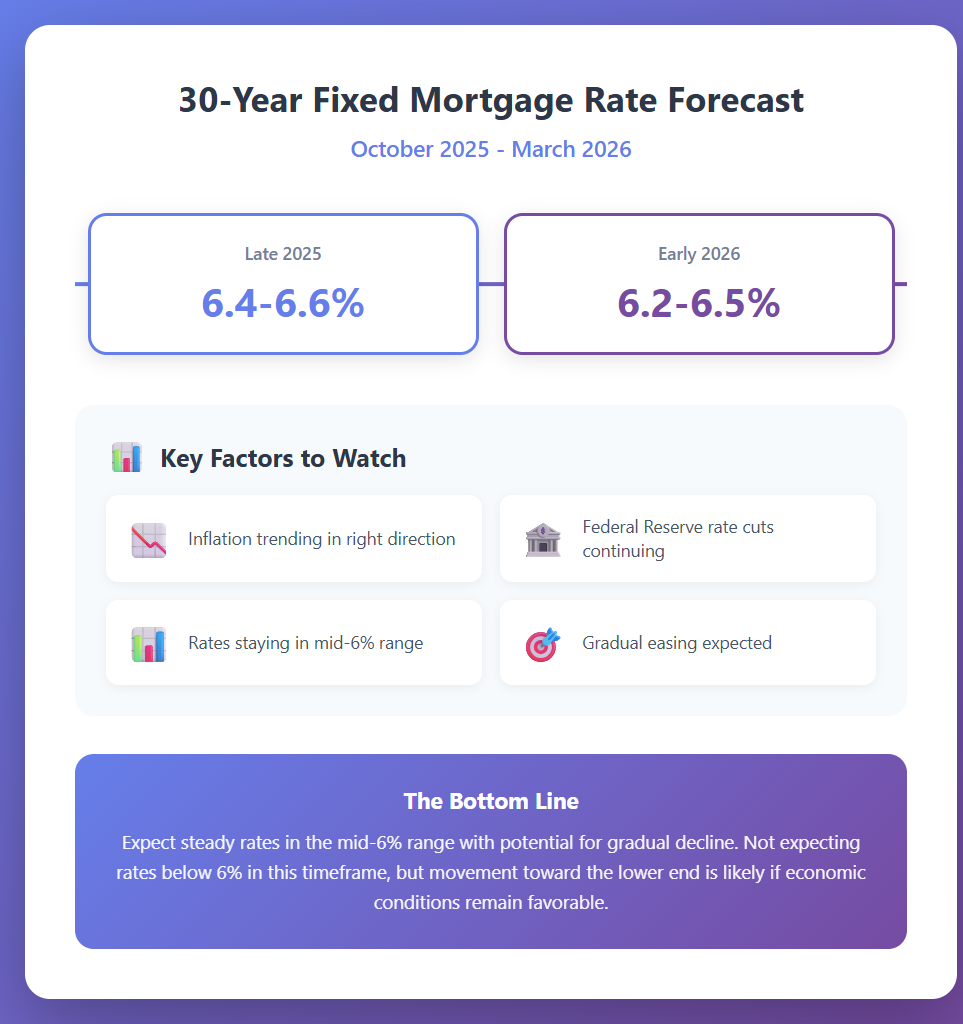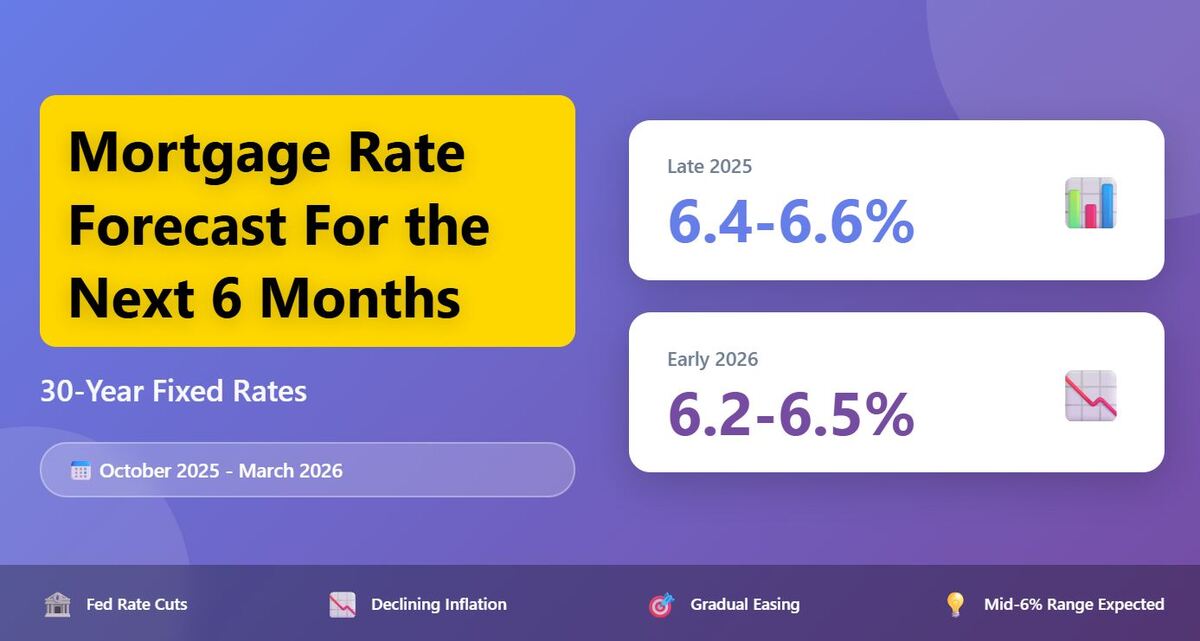Thinking about buying a home or perhaps refinancing your current one? If so, you're probably wondering what's going to happen with mortgage rates over the next six months. My best guess, looking at all the expert chatter and economic signs, is that we'll see 30-year fixed mortgage rates generally stay in the mid-6% range through October 2025 to March 2026. There's a good chance they could ease a little bit further if inflation keeps heading in the right direction and the Federal Reserve continues to cut interest rates.
Mortgage Rates Forecast for Next 6 Months: October 2025 to March 2026
It’s a delicate dance, isn't it? We’ve all lived through the roller coaster ride of mortgage rates over the past few years. It feels like just yesterday we were talking about rates below 3%, and then suddenly, they shot up. Now, we're in a more stable, albeit higher, range. My take is that for the period from October 2025 through March 2026, things are likely to be pretty steady, with a possible, gradual dip.
We're not talking about rates suddenly plummeting below 6% within this timeframe, but a move towards the lower end of the mid-6% range, say from around 6.4% to 6.6% towards the end of 2025, possibly easing to 6.2% to 6.5% as 2026 begins, is what I’m seeing. Of course, the economy is a living, breathing thing, and unexpected events could certainly shake things up.

Where We Stand Today: October 2025 Snapshot
To get a handle on where we're going, it helps to know where we are. As I write this in late September 2025, the average rate for a 30-year fixed-rate mortgage is hovering around 6.3%, according to Freddie Mac's reliable surveys. This figure follows a year that saw quite a bit of movement, with rates bouncing between 6.26% and a higher 7.04%. A big reason for the recent dip has been the Federal Reserve's move to cut rates by a quarter-point in September. They've also given signals that more cuts might be on the way.
Looking ahead to the next six months, the general feeling is one of stability with a slight softening. This optimism is largely tied to the expectation that the Fed will make two to three more rate cuts by mid-2026. However, it’s never that simple. Things like how trade policies evolve and pressures from the global economy can introduce a lot of uncertainty, making crystal-clear predictions tough.
What Really Moves the Mortgage Rate Needle?
It’s not magic; mortgage rates are deeply connected to bigger economic forces. The 10-year Treasury yield is a key indicator, and it moves based on all sorts of economic news. For our predictions, a few big players stand out:
- Inflation: This is probably the biggest one. If prices are rising too fast, the Fed typically raises interest rates to cool things down. Some estimates suggest inflation might peak around 3.1% in mid-2026. If it cools off faster, that's good news for lower mortgage rates.
- Unemployment: When more people have jobs, the economy is usually strong. If unemployment starts to climb, it can signal a slowdown, which might lead the Fed to lower rates. We’re looking at unemployment possibly ticking up to about 4.5%-4.8% in the coming months.
- GDP Growth: This is the overall measure of how well the economy is doing. The forecast is for annual GDP growth to be somewhere between 1.7% and 2.3%. Slower growth might encourage lower rates.
If inflation shows us a faster downward trend than expected, we could see mortgage rates dip more significantly. On the flip side, if inflation stays stubbornly high, or if the job market starts to weaken considerably, those hoped-for rate decreases might be put on hold.
What This Means for You: Buyers and Homeowners
So, how does all this affect you?
For prospective homebuyers, these rates still mean a significant chunk of change. On a $400,000 loan, a 6.4% rate translates to about $2,500 a month just for the principal and interest, not even counting taxes and insurance. Affordability remains a challenge, but it's definitely better than where we were when rates were higher.
If you're a homeowner with a mortgage from a year or two ago, you might have been caught with a higher rate. The good news is that refinancing activity has really picked up – up 42% year-over-year. As rates edge lower, this is a prime opportunity for many to potentially lower their monthly payments and save money over the life of their loan.
And what about sellers? If rates dip below that 6.5% mark, we might see more homeowners who’ve been hesitant to sell (because they don't want to give up their super-low old rate) finally decide to list their homes. This could mean more homes hitting the market, which is good for buyers who’ve been facing tight inventory.
Overall, it paints a picture of a housing market that's slowly thawing, not a sudden explosion. Patience and planning are still key.
A Bit of History to Set the Scene
To truly appreciate the predictions, let's glance back. For years after the 2008 financial crisis, mortgage rates were incredibly low, even dipping below 3% at times during the pandemic. It was a great time to buy. But then, to fight rising inflation, the Federal Reserve started hiking interest rates aggressively in 2022 and 2023. We saw peaks of nearly 7.8% in 2023! This surge is what caused the “lock-in effect” where so many homeowners who had rates under 4% decided to stay put, which, in turn, made it harder for buyers to find homes.
In 2024, rates eased a bit, fluctuating between roughly 6.08% and 7.22%. This trend of moderating rates continued into 2025, with the average for a 30-year fixed staying between 6.26% and 7.04%. The Fed's September 2025 rate cut, plus signals of more to come, have really shaped this path. As of late September 2025, the 30-year fixed is around 6.30%, and the 15-year fixed is at 5.49%. This downward path is encouraging, but experts caution we're unlikely to see rates jump back to those sub-3% levels anytime soon. The economy has changed, and there are new baseline expectations for inflation.
The “lock-in effect” is loosening its grip a bit this year. Refinance applications are up a healthy 42%, and purchase applications have risen 18% compared to last year. This is a good sign of growing confidence. Still, the number of homes for sale isn't quite where it used to be. We expect home sales to gradually recover, from about 4.85 million units in 2025 to 5.35 million in 2026.
The Big Players in Rate Setting
We’ve talked about the Fed’s rate cuts. But what else is a big deal?
- The Federal Reserve's Federal Funds Rate: This is the rate banks charge each other for overnight borrowing. While it’s a short-term rate, it has a ripple effect on longer-term rates like mortgages, mainly by influencing the 10-year Treasury yield. In September 2025, the Fed trimmed its rate to a range of 5.00%-5.25%. Markets are guessing they'll cut rates by another 0.75% to 1.00% by March 2026. This all hinges on inflation getting closer to the Fed's 2% target. Current outlooks put core PCE inflation (a measure the Fed watches closely) at 2.5%-3.1% in late 2025.
- Unemployment Figures: As I mentioned, a rising unemployment rate can make the Fed more inclined to cut rates. If the labor market softens a bit, moving towards that 4.5%-4.8% range by early 2026, it could push the Fed to act more decisively on rate cuts.
- Gross Domestic Product (GDP) Growth: The economy's expansion rate is crucial. For 2025, GDP is projected at 1.7%, and for 2026, it's expected to be around 2.1%-2.3%. If there are concerns about this growth slowing down more than expected, the Fed might consider lowering rates. Things like trade policy and consumer spending can influence this.
- Global Events: It’s not just U.S. news that matters. Geopolitical issues or supply chain problems anywhere in the world can sometimes lead to rising inflation, which, in turn, can push interest rates higher.
- Housing Specifics: Home price growth is also a factor. If prices cool down significantly, it can affect buyer demand and have an indirect impact on mortgage rates. We're currently seeing forecasts for home price growth to slow to about 2.8% in 2025 and just 1.1% in 2026.
What the Experts Are Saying: A Summary
When you look at what major organizations like Fannie Mae, the Mortgage Bankers Association (MBA), and others are predicting, it's clear there's a general agreement that rates will likely stay in the mid-6% range.
Here's a simplified look at some of their forecasts, keeping in mind these are educated guesses:
| Forecast Source | Q4 2025 (Oct-Dec) Average | Q1 2026 (Jan-Mar) Average | Key Assumptions |
|---|---|---|---|
| Fannie Mae (September 2025) | Roughly 6.4% | Around 6.2% | Inflation moderating, Fed cuts, GDP around 1.7% |
| Mortgage Bankers Assoc. (MBA) | Around 6.4% | Around 6.4% | Higher inflation forecast (3.6%), slower GDP growth (1.3%), 10-Year Treasury at 4.2% |
| Freddie Mac (Interpretation) | Around 6.4% | Around 6.2% | Focus on market trends and resilience reflecting moderate easing |
| National Association of REALTORS® | Around 6.5% | Closer to 6.0% | More optimistic about early 2026 declines |
| Wells Fargo (General Tone) | Potentially 6.3% | N/A | Lower-end forecast tied to faster Fed cuts and weakening labor market |
Looking at this, you can see a consensus forming around the mid-6% mark. Fannie Mae seems a bit more optimistic about rates trending downwards more significantly by early 2026. If you were to plot these on a graph, you'd probably see a gentle slope downwards from about 6.45% in October 2025 to around 6.20% by March 2026. Different groups will have slightly different numbers because they're working with slightly different assumptions about how fast inflation will fall or how active the Fed will be.
Expert Splits and Nuances
Even among the pros, there’s a bit of divergence. Lawrence Yun, the Chief Economist for the National Association of REALTORS®, is quite optimistic, suggesting rates could flirt with 6% by early 2026. On the other hand, analysts from institutions like Wells Fargo might lean towards a more conservative view, perhaps seeing rates dip a bit faster if economic data supports it, but still within the general trend.
The core of these differing opinions often comes down to how quickly inflation will fall and how many times the Federal Reserve will cut rates. Some anticipate a more aggressive Fed response to signs of economic slowing, while others believe inflation might prove more stubborn, requiring the Fed to tread more carefully.
Thinking About Scenarios: What Could Happen?
It’s always smart to consider different possibilities. Here’s how I see things playing out:
- The Most Likely Scenario (Base Case): We’ll see rates average around 6.4% in the last quarter of 2025 and ease to about 6.3% in the first quarter of 2026. This assumes inflation continues to cool to around 2.5%, unemployment stays manageable at about 4.6%, and the Fed makes two rate cuts. This would support a modest but steady increase in home sales.
- The Good News Scenario (Best Case): What if inflation drops faster than expected, maybe to 2.2%? In this scenario, rates could potentially dip below 6.0% by March 2026. This would be fantastic news, likely leading to a surge in mortgage applications and making it significantly easier for people to afford homes.
- The Worrying Scenario (Worst Case): On the flip side, what if inflation stubbornly sticks around 3.5%, or some major global event causes economic disruption? This could shock the system and push rates back up, maybe to around 6.8%. This would likely slow down the housing market considerably, with fewer sales and a potential rise in unemployment.
How Does This Impact You Personally?
- For Buyers: If rates stay in the mid-6% range, those monthly payments will still be substantial. Affordability is still a key word. First-time buyers might find programs like FHA loans helpful, as they often have rates that are a bit lower than conventional loans (sometimes by 0.5% or more).
- For Sellers: If rates soften, especially below 6.5%, you might see more homes coming onto the market. This could mean a bit more competition for you, but potentially also a modest increase in home prices in early 2026, maybe 1%-2%.
- For Refinancers: This is probably where the biggest wins will be. If you've got a mortgage with a rate significantly higher than what's predicted for the coming months, refinancing could save you hundreds of dollars each month.
- For the Economy: Stable rates that support a gradual housing market recovery are good for overall economic growth, helping to keep that GDP growth around the projected 2% mark. However, if rates stay stubbornly high for too long, it could dampen consumer spending.
A Look Back to Inform the Future
When we compare the October 2025 to March 2026 outlook with the same period a year ago (October 2024 to March 2025), we were looking at higher rates, generally in the 6.5% to 7.0% range. That meant fewer home sales. The current predictions suggest a 5%-10% improvement in housing activity compared to that period. It’s definitely a much more favorable picture, though still quite different from the ultra-low rates we saw before 2022. Compared to international markets, U.S. mortgage rates are still on the higher side, reflecting different economic policies in places like the UK or Europe where rates might be 3%-4%.
Related Topics:
Mortgage Rates Predictions for Next 90 Days: October to December 2025
Mortgage Rate Predictions October 2025: Will Rates Go Down?
Mortgage Rates Predictions for the Next 12 Months: Sept 2025 to Sept 2026
Your Questions on Mortgage Rates Answered & What to Do Next
Let’s tackle some common questions:
- Will mortgage rates drop below 6% soon? It's unlikely within the next six months (October 2025 to March 2026). We might see it happen by later in 2026 if economic trends continue positively.
- Should I buy a home now, or wait? This is the million-dollar question! If the current predicted rates fit your budget and you’ve found the right home, buying now means securing your place and potentially avoiding future price increases. Waiting could mean missing out on a dip in rates, but it could also mean catching a better rate if things play out optimistically. It’s a personal decision based on your financial situation and risk tolerance.
- What about Adjustable-Rate Mortgages (ARMs)? ARMs are currently offering lower introductory rates, often in the 5.5%-6.0% range. They can save you money in the short term, but you need to be comfortable with the risk that your rate could go up when it resets.
- Practical Tips:
- Stay Informed: Keep an eye on the weekly Freddie Mac mortgage rate survey.
- Lock Your Rate: When you find a rate you’re happy with, talk to your lender about locking it in.
- Consider Points: You can sometimes pay “points” (a percentage of the loan amount) upfront to lower your interest rate. Figure out if this makes sense for you long-term.
- Talk to Lenders: Get quotes from multiple lenders and discuss your personal financial situation to understand your options.
In the end, navigating the mortgage market from October 2025 to March 2026 is about being informed and prepared. While the signs point to a generally favorable, stable environment with a slight downward trend, the economy always has a few surprises up its sleeve. By staying in tune with the data and expert forecasts, you'll be well-equipped to make the best decisions for your financial future.
Invest Smarter in a High-Rate Environment
With mortgage rates remaining elevated, it's more important than ever to focus on cash-flowing investment properties in strong rental markets.
Norada helps investors like you identify turnkey real estate deals that deliver predictable returns—even when borrowing costs are high.
HOT NEW LISTINGS JUST ADDED!
Connect with a Norada investment counselor today (No Obligation):
(800) 611-3060
Also Read:
- Will Mortgage Rates Go Down in 2025: Morgan Stanley's Forecast
- Mortgage Rate Predictions 2025 from 4 Leading Housing Experts
- 30-Year Fixed Mortgage Rate Forecast for the Next 5 Years
- 15-Year Fixed Mortgage Rate Predictions for Next 5 Years: 2025-2029
- Will Mortgage Rates Ever Be 3% Again in the Future?
- Mortgage Rates Predictions for Next 2 Years
- Mortgage Rate Predictions for Next 5 Years
- Mortgage Rate Predictions: Why 2% and 3% Rates are Out of Reach
- How Lower Mortgage Rates Can Save You Thousands?
- How to Get a Low Mortgage Interest Rate?
- Will Mortgage Rates Ever Be 4% Again?



